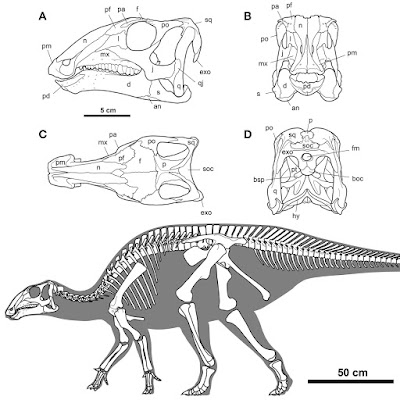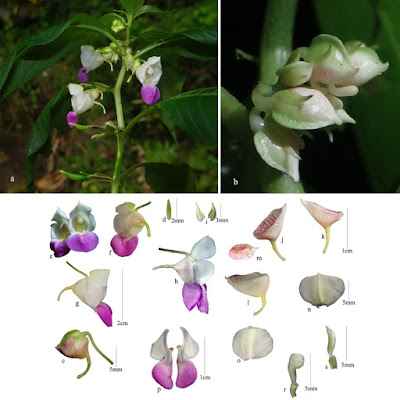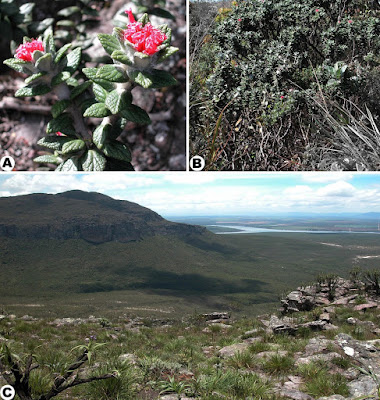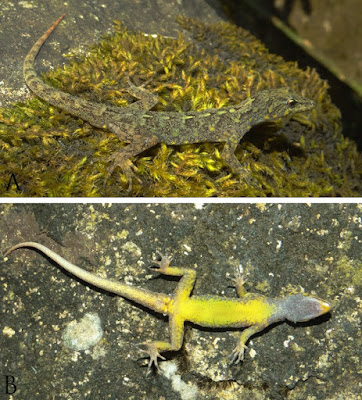[Most Recent Entries] [Calendar View]
Friday, April 19th, 2019
| Time | Event | ||||
| 1:55a | [Arachnida • 2019] A Revision of the Endemic South African Long-jawed Ground Spider Genus Drassodella Hewitt, 1916 (Araneae: Gallieniellidae)
Abstract The genus Drassodella Hewitt, 1916 is one of four Afrotropical genera of Gallieniellidae, and is presently represented by seven species, all endemic to South Africa. The type material of six of the described species was studied and they are redescribed from both sexes: D. melana Tucker, 1923, D. quinquelabecula Tucker, 1923, D. salisburyi Hewitt, 1916, D. septemmaculata (Strand, 1909), D. tenebrosa Lawrence, 1938 and D. vasivulva Tucker, 1923. Of these, the males of D. melana, D. tenebrosa and D. vasivulva are described for the first time. Recent field work yielded additional females of D. purcelli Tucker, 1923 from the vicinity of the type locality, and this sex is redescribed; the male remains unknown. A further 12 new species are recognized: D. amatola sp. nov. (♀ ♂), D. aurostriata sp. nov. (♀ ♂), D. baviaans sp. nov. (♂), D. flava sp. nov. (♀ ♂), D. guttata sp. nov. (♀ ♂), D. lotzi sp. nov. (♀), D. maculata sp. nov. (♀), D. montana sp. nov. (♀ ♂), D. tolkieni sp. nov. (♀ ♂), D. trilineata sp. nov. (♀), D. transversa sp. nov. (♀ ♂) and D. venda sp. nov. (♀ ♂). Based on the genitalic structures, there appear to be two distinct species groups. The D. melana species group, which includes D. melana, D. tenebrosa and eight new species mainly distributed in eastern and northern South Africa, is characterised by very conservative genitalic morphology in both sexes. The D. salisburyi species group, with considerable variation in the structure of the copulatory organs and distributed in the southern half of South Africa, includes the remaining nine species, of which four are new. Although D. tenebrosa represents an intermediate between the two groups, with palpal morphology more typical of the D. melana species group and epigynal morphology typical of the D. salisburyi group, it is placed in the former species group based on its distribution in eastern South Africa. The biology, habitat preferences and biogeography of Drassodella are briefly discussed. Keywords: Araneae, genitalia, new species, species group, Afrotropical, biome, biogeography Zingisile Mbo and Charles R. Haddad. 2019. A Revision of the Endemic South African Long-jawed Ground Spider Genus Drassodella Hewitt, 1916 (Araneae: Gallieniellidae). Zootaxa. 4582(1); 1-62. DOI: 10.11646/zootaxa.4582.1.1 | ||||
| 3:53a | [Paleontology • 2019] Gobihadros mongoliensis • A New Hadrosauroid (Dinosauria: Ornithopoda) from the Late Cretaceous Baynshire Formation of the Gobi Desert (Mongolia)
Abstract A new genus and species of non-hadrosaurid hadrosauroid, Gobihadros mongoliensis, is described from a virtually complete and undeformed skull and postcranial skeleton, as well as extensive referred material, collected from the Baynshire Formation (Cenomanian-Santonian) of the central and eastern Gobi Desert, Mongolia. Gobihadros mongoliensis is the first non-hadrosaurid hadrosauroid from the Late Cretaceous of central Asia known from a complete, articulated skull and skeleton. The material reveals the skeletal anatomy of a proximate sister taxon to Hadrosauridae in remarkable detail. Gobihadros is similar to Bactrosaurus johnsoni and Gilmoreosaurus mongoliensis, but can be distinguished from them in several autapomorphic traits, including the maximum number (three) of functional dentary teeth per tooth position, a premaxillary oral margin with a ‘double-layer morphology’, and a sigmoidal dorsal outline of the ilium with a well-developed, fan-shaped posterior process. All of these characters in Gobihadros are inferred to be convergent in Hadrosauridae. Phylogenetic analysis positions Gobihadros mongoliensis as a Bactrosaurus-grade hadrosauromorph hadrosauroid. Its relationship with Maastrichtian hadrosaurids from Asia (e.g., Saurolophus angustirostris, Kerberosaurus manakini, Wulagasaurus dongi, Kundurosaurus nagornyi) are sufficiently distant to indicate that these latter taxa owe their distribution to migration from North America across Beringia, rather than having a common Asian origin with Go. mongoliensis. Systematic Palaeontology ORNITHISCHIA Seeley, 1887 ORNITHOPODA Marsh, 1881 [42] IGUANODONTIA sensu Sereno, 1998 HADROSAUROIDEA sensu Sereno 1998 Gobihadros nov. gen. Gobihadros mongoliensis nov. sp. Etymology. Hadrosauroid from the Gobi Desert of Mongolia. Holotype. MPC-D100/746, a complete, nearly articulated skeleton from sub-locality I of Bayshin Tsav. Locality and horizon. Bayshin Tsav (South Gobi Aimag); Khoorai Tsav (South Gobi Aimag); Khongil Tsav (East Gobi Aimag); Baynshire Formation (Cenomanian-Santonian), Upper Cretaceous. Diagnosis. Small hadrosauroid that differs from all other non-hadrosaurid hadrosauroids (including Bactrosaurus and Gilmoreosaurus) in the presence of a premaxilla with a ‘double-layer’ oral margin and up to three functional teeth in the dentary tooth row (both convergent in Hadrosauridae). Gobihadros differs from Bactrosaurus johnsoni, Probactrosaurus gobiensis, Eolambia caroljonesi, Claosaurus agilis, Tethyshadros insularis, in the sigmoidal dorsal outline of the ilium and the greater lateral expression of the supracetabular crest. Gobihadros differs from T. insularis, Plesiohadros djaktaensis, and Hadrosauridae in the possession of a spike-like manus digit 1. Khishigjav Tsogtbaatar, David B. Weishampel, David C. Evans and Mahito Watabe. 2019. A New Hadrosauroid (Dinosauria: Ornithopoda) from the Late Cretaceous Baynshire Formation of the Gobi Desert (Mongolia). PLoS ONE. 14(4): e0208480. DOI: 10.1371/journal.pone.0208480 | ||||
| 4:22a | [Botany • 2019] Impatiens kamrupana (Balsaminaceae) • A New Species from Assam, India
Abstract Impatiens kamrupana, a new species from Assam, northeast India is described. The new species is easily distinguished from its allied taxa by its bicoloured, white and purple flowers and sub-bucciniform lower sepal with straight to slightly curved spur. Keywords: Balsam, Northeast India, Novelty, Eudicots Impatiens kamrupana Gogoi, J.Sarma & Borah sp. nov. Etymology:— The species epithet is named after its type locality i.e. district Kamrup of Assam state.
Souravjyoti Borah, Jatindra Sarma and Rajib Gogoi. 2019. Impatiens kamrupana (Balsaminaceae): A New Species from Assam, India. Phytotaxa. 395(1); 35–40. DOI: 10.11646/phytotaxa.395.1.4 | ||||
| 9:20a | [Botany • 2019] Stachytarpheta atkinsiae (Verbenaceae) • A New Species endemic to the Chapada Diamantina, Bahia, Brazil
Abstract Stachytarpheta atkinsiae, belonging to the Radlkoferiana group from the Chapada Diamantina, Bahia state Brazil, is here described. It is a red-flowered species, and unusual in being a large, much-branched shrub, with densely lanate indumentum. The species shows similarities with S. froesii and S. radlkoferiana, but differs from both vegetative and floral characters. We provide a full description of the species, together with illustrations, a conservation status assessment, and a distribution map. Keywords: “campo rupestre”, endemic species, Serra do Espinhaço, taxonomy 
Stachytarpheta atkinsiae Harley & Giul. sp. nov. Type:— BRAZIL. Bahia: Mucugê, Serra do Gobira, ca. 8,4 km ao sul de Mucugê em linha reta, na última subida próxima ao cume, ...., 1555 m. Campo rupestre entre pedras, 19 January 2005, R.M. Harley, A.M. Giulietti & E. Ribeiro 55488 (holotype HUEFS; Isotypes K, MG, SPF). Stachytarpheta atkinsiae is morphologically similar to S. froesii Moldenke, S. radlkoferiana Mansfeld var. radlkoferiana and S. radlkoferiana var. lanata S.Atkins. All taxa are red-flowered and those species are the only ones to share with S. atkinsiae the discolorous leaves, ± glabrous on adaxial surface and white-lanate on abaxial surface and with a revolute margin. S. atkinsiae has leaves sessile or with petiole up to 2 mm long, lamina 2.0–3.7 × 1.0–2.3 cm, elliptic, apex obtuse; bracts linear, 10–12.5 mm long; base of flowers obscured by lanate indumentum. S. froesii differs from the new species as follows: it has leaves with petiole 5–8 mm long, lamina 1.5–2.8 × 1.4–2.5 cm, broadly obovate, apex rotund to truncate, base of flowers not obscured by lanate indumentum and especially because the bracts which are linear as in S. atkinsiae, measure only c. 4 mm long. S. radlkoferiana var. radlkoferiana and var. lanata differ from the new species as both possess obovate and not linear bracts, as well as having much smaller, sessile leaves. S. radlkoferiana var. radlkoferiana has imbricate leaves on the young shoots, 0.7–1.5 × 0.4–0.8 cm., linear-elliptic to long-triangular or narrowly oblong, while S. radlkoferiana var. lanata has ovate leaves, which measure 1.0–1.4 × 0.5–0.7 cm.   Distribution and ecology:— S. atkinsiae is known only from the Serra do Gobira, in the municipality of Mucugê, in Bahia (Map 1). The species occurs only in campo rupestre vegetation in sandy rocky dry soils. It is recorded from high elevation areas (1400 to 1570 m) in campo rupestre vegetation, in sandy rocky dry soils. Flowers and fruits were registered in September and January (most collections in this month). Etymology:— The specific epithet honors Sandy Atkins who worked at the Royal Botanic Gardens, Kew. Sandy Atkins is the author of the revision of Stachytarpheta in Brazil (Atkins 2005), a superb work that is currently the most up-to-date and important contribution to our knowledge of the genus. Raymond M. Harley, Guilherme Medeiros Antar and Ana Maria Giulietti. 2019. Stachytarpheta atkinsiae, A New Species of Verbenaceae endemic to the Chapada Diamantina, Bahia, Brazil. Phytotaxa. 401(2); 127–132. DOI: 10.11646/phytotaxa.401.2.4 Resumo: Nesse trabalho está sendo descrita Stachytarpheta atkinsiae pertencente ao Grupo Radlkoferiana e de ocorrência na Chapada Diamantina, Bahia, Brasil. É uma espécie vistosa, com flores vermelhas, e bem distinta por ser um arbusto alto, robusto e ramificado, com ramos densamente lanados. A espécie tem semelhanças com S. froesii e com S. radlkoferiana, mas difere por caracteres vegetativos e florais. É apresentada descrição detalhada, ilustrações, fotos em campo, análise do estado de conservação, e mapa de distribuição. | ||||
| 9:32a | [Herpetology • 2019] Rediscovery of Cnemaspis nilagirica (Squamata: Gekkonidae) from Kerala, India with Notes on Morphology and Distribution
Abstract Cnemaspis nilagirica was described by Manamendra-Arachchi, Batuwita and Pethiyagoda in 2007 based on a single female specimen that was a syntype of Gonatodes kandianus var. tropidogaster described by Boulenger in 1885. However, a living population of this species has not been reported since its original description by Boulenger. Based on fresh material and comparisons with the holotype of C. nilagirica, we here report the collection of this species after over 130 years. We provide the first description of a male specimen and additional information on morphological variation, distribution and natural history. Keywords: Reptilia, Day geckos, Nilgiri Hills, Western Ghats
Vivek Philip Cyriac, Alex Johny, Pavukandy Umesh, Muhamed Jafer Palot and Patrick D. Campbell. 2019. Rediscovery of Cnemaspis nilagirica Manamendra-Arachchi, Batuwita and Pethiyagoda, 2007 (Squamata: Gekkonidae) from Kerala, India with Notes on Morphology and Distribution. Zootaxa. 4586(1); 98–108. DOI: 10.11646/zootaxa.4586.1.4 researchgate.net/publication/332440158_R  |
| << Previous Day |
2019/04/19 [Calendar] |
Next Day >> |

















